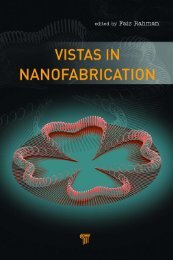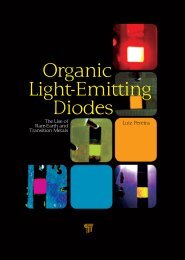Download PDF - Pan Stanford Publishing
Download PDF - Pan Stanford Publishing
Download PDF - Pan Stanford Publishing
Create successful ePaper yourself
Turn your PDF publications into a flip-book with our unique Google optimized e-Paper software.
xvi<br />
Preface<br />
nanominerals is not restricted to experimental techniques, and Salvy<br />
Russo and Andrew Hung describe ways that advanced computer<br />
simulation and theoretical modeling can help us determine how to<br />
model and predict how different sizes, shapes, and structures are<br />
formed. We then move on to nanomaterials that are rarer in Nature,<br />
such as gold nanoparticles in ores, described by Robert Hough<br />
and colleagues, and diamondoids extracted from oil, described by<br />
Christoph Bostedt and colleagues. In all of these cases, the natural<br />
nanomaterials have “positive curvature” (that is, they present as<br />
small solid particles); so we conclude this section by considering<br />
the opposite position. The final chapter of this section by Huifang<br />
Xu describes natural nanomaterials with “negative curvature,” and<br />
explains the role of these nanosize pores (or voids) in regulating<br />
reactivity and transport of uranium in subsurface sediments.<br />
Nanomaterials are not the only thing Nature has beaten us to;<br />
Nature has developed its own nanotechnology too. In Part II, we<br />
reveal some of the ways that Nature combines nanoparticles to form<br />
more complex structures, each with a specific application in mind.<br />
The vast majority of these applications are in the realm of biology,<br />
and keynote authors Jun Wu, Juming Yao, and Yurong Cai describe<br />
how our own bodies contain bones with hierarchical structure based<br />
on nanoparticles. We then turn our attention back to iron oxides and<br />
see how the smallest life forms use these magnetic nanoparticles, in<br />
a chapter by André Körnig and Damien Faivre. Bacteria are not the<br />
only life forms to use magnetic nanoparticles, and Ilia A. Solov’yov<br />
and Walter Greiner explain the properties and function of nanoscale<br />
magnetoreceptors in birds. In each case, these nanoparticles have<br />
not been inhaled, ingested or inserted but are formed in situ by<br />
the organism, in an environment that is very different from that of<br />
nanominerals. To understand the formation mechanisms, computer<br />
simulations are again instructive, and John H. Harding and colleagues<br />
explain how modeling the nucleation and growth of biomaterials<br />
to aid in understanding. This section concludes with a chapter by<br />
Ainsley E. Seago and Vinodkumar Saranathan, who focus on some of<br />
Nature’s nanotechnology residing outside the body, in the beautiful<br />
photonic crystals decorating the wings and exoskeletons of beetles.<br />
Both Earth and its inhabitants have lived with (and benefited<br />
from) Nature’s nanostructures for millennia, but as our Part III<br />
keynote authors Frans J. M. Rietmeijer and Joseph A. Nuth show us<br />
that some nanoparticles are “out of this world.” While nanoparticles
















